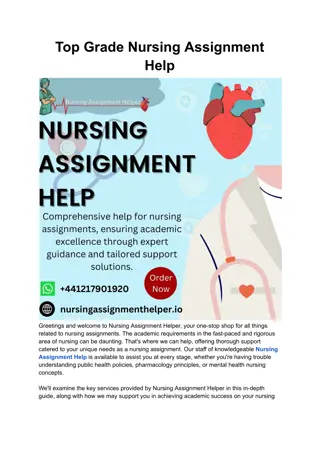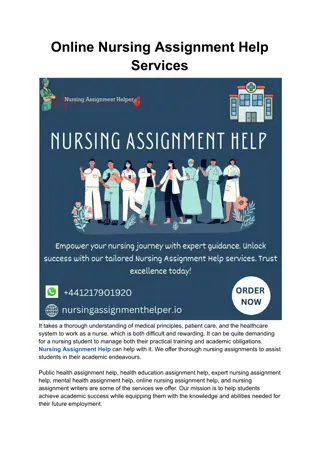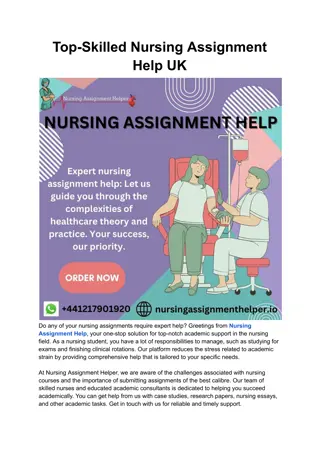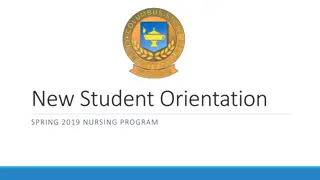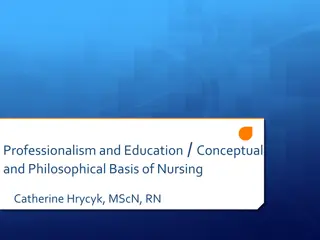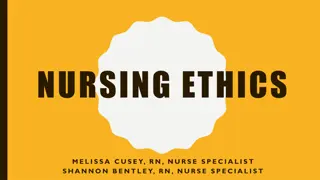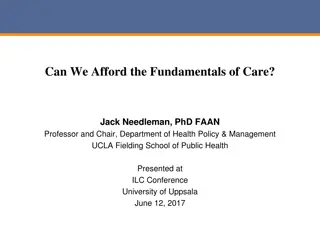Effective Communication in Nursing: Key Concepts and Phases
Communication in nursing plays a vital role in establishing relationships, expressing empathy, and providing care information. This article explores the purposes and types of communication in nursing, emphasizing the significance of verbal and non-verbal cues. Additionally, it delves into the phases of therapeutic communication, including the orientation, working, and termination phases, highlighting the importance of building trust and achieving treatment goals.
Download Presentation

Please find below an Image/Link to download the presentation.
The content on the website is provided AS IS for your information and personal use only. It may not be sold, licensed, or shared on other websites without obtaining consent from the author. Download presentation by click this link. If you encounter any issues during the download, it is possible that the publisher has removed the file from their server.
E N D
Presentation Transcript
University of Basrah College of Nursing Health Promotion Course Fourth Year Students First Semester 2023
Lecture no. 9 Communication in nursing Lecturer Dr. Husham Husain
Communication in nursing Communication in nursing is a complex process of sending and receiving verbal and non-verbal messages allows for exchange of information, feelings, needs, and preferences.
Purposes of Communication 1/ To establish nurse-patient relationship. 2/ To be effective in expressing interest for patient and family. 3/ To provide health care information.
Types of Communication 1. Verbal Communication - Use of spoken or written word. - Choice of words can reflect age, education and culture. 2. Non-Verbal Communication - Use of expressions or behaviors (body language). - Less conscious than verbal
How we communicate non-verbally: - physical appearance. - Posture / gait. - Facial expressions.
Phases of Therapeutic Communication 1/ Orientation Phase: The orientation phase is the first stage of the therapeutic relationship, in which the nurse and client become acquainted with each other and establish trust. The orientation stage is especially important because it is the time in which the foundation for the relationship is established.
2/ Working Phase: In this stage the problems are identified, goals are established, and problem-solving methods are selected. Actions are chosen after carefully considering both the consequences of actions and the client s values.
3/ Termination Phase: This phase is focused on the evaluation of goal achievement and effectiveness of treatment. It is important that the client has been prepared for the final stage of the relationship by encouraging discussion of feelings.
Evaluation the Effectiveness of Health Promotion
Evaluation is a way of assessing whether the promotion activities has met its objectives. It is important to evaluate the activities because: 1. It will give a sense of achievement. 2. Help to work out ways to improve it for next time. 3. Enable other people to learn from it when developing their own plan.
There are two general approaches used for evaluation: quantitative and qualitative. 1) Quantitative evaluation is based on the numbers that can be measured, whether it is the number of people who attend an activities of health promotion or the number of people who change their behavior.
It is a more structured way to evaluate and would usually require a base to start from. For example, if the objective was to halve the number of people who smoked in the community by the end of the project, it would need to know how many people smoked at the beginning of the project.
2) Qualitative evaluation is how well an activity was delivered and received. It depend on: A. people expressing their thoughts and opinion. B. how people engaged with the activities. C. how they felt about doing the activity.
HOMEWORK Q1/ How we communicate non-verbally ? Q2/ What are the purposes of Communication ?







